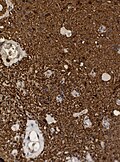Difference between revisions of "Diffuse astrocytoma"
Jump to navigation
Jump to search
Jensflorian (talk | contribs) (+pic) |
Jensflorian (talk | contribs) (update) |
||
| Line 5: | Line 5: | ||
* Usually shows progression to [[glioblastoma]] sooner or later. | * Usually shows progression to [[glioblastoma]] sooner or later. | ||
Previously categorized as follows:{{Ref WHOCNS|25}} | Previously categorized as follows:<ref name=WHOCNS>{{Ref WHOCNS|25}}</ref> | ||
*Diffuse astrocytoma ICD-O: 9400/3 | *Diffuse astrocytoma ICD-O: 9400/3 | ||
**Fibrillary astrocytoma ICD-O: 9420/3 - most frequent | **Fibrillary astrocytoma ICD-O: 9420/3 - most frequent | ||
| Line 11: | Line 11: | ||
**Protoplasmatic astrocytoma ICD-O:9410/3 - rare | **Protoplasmatic astrocytoma ICD-O:9410/3 - rare | ||
Note: This subtyping is no longer in use! | Note: This subtyping is no longer in use! | ||
==Radiology/Clinic== | |||
*Mass effect. | |||
*Seizures. | |||
*Neurologic decifit. | |||
*Usually not contrast-enhanching, T2 bright. | |||
==Macroscopy== | |||
*No clear demarcation from white matter | |||
*May contain larger cysts | |||
*No necrosis | |||
==Histology== | ==Histology== | ||
Features: <ref name=AFIP2007>{{Ref AFIP2007|34}}</ref> | |||
*Cell density higher than normal brain. | *Cell density higher than normal brain. | ||
*Mild to moderate nuclear pleomorphism. | *Mild to moderate nuclear pleomorphism. | ||
**Monotony of atypical nuclei | **Monotony of atypical nuclei and irregular distribution indicates neoplasm. | ||
**"naked nuclei" without recognizeable processes. | |||
**No prominent nucleolus. | |||
*Cytoplasm highly variable (even within the same tumour). | *Cytoplasm highly variable (even within the same tumour). | ||
**In normal CNS the cytoplasm blends within the neuropil. | **In normal CNS the cytoplasm blends within the neuropil. | ||
*Mitoses absent or very rare. | *Mitoses absent or very rare. | ||
*Microcystic | *Microcystic spaces of the background (none to extensive). | ||
*No necrosis, no vascular proliferations. | *No necrosis, no vascular proliferations. | ||
**Except radiation necrosis. | |||
*Lymphocytic cuffing (mostly in gemistocytic type) | |||
*Abent to few rosenthal fibers. | |||
<gallery> | |||
File:Diffuse_astrocytoma_HE_stain.jpg | Diffuse astrocytoma, [[H&E]] (WC/jensflorian) | |||
File:Image NP T2a 0002.JPG | Diffuse astrocytoma, [[H&E]] (WC/jensflorian) | |||
File:Astrocytoma whoII HE.jpg | Astrocytoma, fibrillary type (WC/jensflorian) | |||
File:Neuropathology case II 02.jpg | Astrocytoma, protoplasmatic type (WC/jensflorian) | |||
</gallery> | |||
==IHC== | ==IHC== | ||
| Line 27: | Line 52: | ||
*Vimentin+ve (often perinuclear). | *Vimentin+ve (often perinuclear). | ||
*S-100+ve. | *S-100+ve. | ||
*p53: Nuclear staining in 30% of the tumours (usually few cells). | |||
*MIB-1: 0-5% (mean: 2%). | *MIB-1: 0-5% (mean: 2%). | ||
*[[IDH-1]] (R132H)+ve in 60-70%. | *[[IDH-1]] (R132H)+ve in 60-70%. | ||
*[[ATRX]] loss in 70%. | *[[ATRX]] loss in 70%. | ||
<gallery> | |||
File:GFAP astrocytoma.jpg| GFAP in astrocytoma (WC/jensflorian) | |||
File:Neuropathology case II 04.jpg | ATRX loss in astrocytoma (WC/jensflorian) | |||
</gallery> | |||
==Molecular== | ==Molecular== | ||
| Line 44: | Line 75: | ||
*[[SEGA]] - esp. gemistocytic forms. | *[[SEGA]] - esp. gemistocytic forms. | ||
=See also= | =See also= | ||
Revision as of 10:16, 22 October 2015
Diffuse astrocytoma (AKA: diffuse, low-grade astrocytoma) is a infiltrating astrocytoma occurring in the CNS white matter.
- Most common grade II WHO glioma in adults (peaks between 30-40 years).
- 10-15% of all astrocytomas.
- Usually shows progression to glioblastoma sooner or later.
Previously categorized as follows:[1]
- Diffuse astrocytoma ICD-O: 9400/3
- Fibrillary astrocytoma ICD-O: 9420/3 - most frequent
- Gemistocytic astrocytoma ICD-O:9411/3
- Protoplasmatic astrocytoma ICD-O:9410/3 - rare
Note: This subtyping is no longer in use!
Radiology/Clinic
- Mass effect.
- Seizures.
- Neurologic decifit.
- Usually not contrast-enhanching, T2 bright.
Macroscopy
- No clear demarcation from white matter
- May contain larger cysts
- No necrosis
Histology
Features: [2]
- Cell density higher than normal brain.
- Mild to moderate nuclear pleomorphism.
- Monotony of atypical nuclei and irregular distribution indicates neoplasm.
- "naked nuclei" without recognizeable processes.
- No prominent nucleolus.
- Cytoplasm highly variable (even within the same tumour).
- In normal CNS the cytoplasm blends within the neuropil.
- Mitoses absent or very rare.
- Microcystic spaces of the background (none to extensive).
- No necrosis, no vascular proliferations.
- Except radiation necrosis.
- Lymphocytic cuffing (mostly in gemistocytic type)
- Abent to few rosenthal fibers.
IHC
- GFAP+ve.
- MAP2+ve (especially in cell processes).
- Vimentin+ve (often perinuclear).
- S-100+ve.
- p53: Nuclear staining in 30% of the tumours (usually few cells).
- MIB-1: 0-5% (mean: 2%).
- IDH-1 (R132H)+ve in 60-70%.
- ATRX loss in 70%.
Molecular
- Absence of LOH 1p/19q.
- Tp53 mutations in approx. 60% (80-90% in gemistocytic, 50% in fibrillary types).
- MGMT promotor methylated in approx. 50%.
DDx
- Reactive astrocytosis.
- Demyelinisation.
- Anaplastic astrocytoma
- Oligoastrocytoma
- Oligodendroglioma - esp. protoplasmatic forms.
- SEGA - esp. gemistocytic forms.
See also
- ↑ The International Agency for Research on Cancer (Editors: Louis, D.N.; Ohgaki, H.; Wiestler, O.D.; Cavenee, W.K.) (2007). Pathology and Genetics of Tumours of Tumors of the Central Nervous System (IARC WHO Classification of Tumours) (4th ed.). Lyon: World Health Organization. pp. 25. doi:10.1007/s00401-007-0243-4. ISBN 978-9283224303.
- ↑ Burger, P.C.; Scheithauer, B.W. (2007). Tumors of the Central Nervous System (Afip Atlas of Tumor Pathology) (4th ed.). Washington: American Registry of Pathology. pp. 34. ISBN 1933477016.





